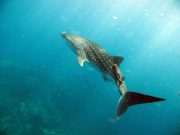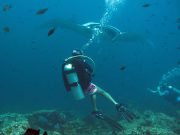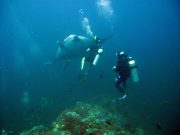Hin Daeng & Hin Muang Diving
Mu Ko Lanta National Park
Hin Daeng and Hin Muang dive sites are two famous rocky pinnacles located at the far south of the Mu Koh Lanta Marine National Park, about 55 km from our beach dive shop on Koh Lanta.
Widely considered to be the best dive sites in Thailand, diving Hin Daeng & Hin Muang by speed boat from Koh Lanta provides the shortest possible journey times to these spectacular dive sites.
We are actually the closest dive shop in Thailand to Hin Daeng & Hin Muang.



With a chance to see manta rays, and possibly whale sharks, reef sharks, and leopard sharks, the pristine corals and stunning dive sites at Hin Daeng & Hin Muang are a must-see for divers visiting Koh Lanta.
Interestingly, the dive sites of Hin Daeng & Hin Muang are actually connected by a long ridge around 40 metres deep, which connects both pinnacles into a single, long rocky dive site, hundreds of metres in length.
These beautiful dive sites are in open seas and whilst most of the time conditions at these dive sites are great, conditions can sometimes be a little more challenging. We recommend divers have recent experience of deeper diving in stronger currents.
Hin Daeng & Hin Muang Marine Life
Stunning Coral Reefs
The nutrient-rich waters around Hin Daeng and Hin Muang attract a wide variety of marine species, ranging from small reef inhabitants to large pelagic visitors.
The pinnacles serve as cleaning stations for manta rays and are frequented by schools of fish, including trevallies, fusiliers, and barracudas.
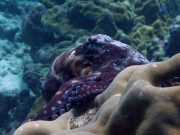
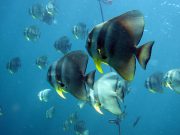
Find out more from the Thailand Department of National Parks on the Mu Koh Lanta Marine National Park.
Corals
The coral formations at Hin Daeng and Hin Muang are equally impressive. These sites are covered in a mix of hard and soft corals, providing shelter for a wide variety of marine species.
The vibrant colours of the soft corals, in particular, give the sites their names—Hin Daeng for its red corals and Hin Muang for its purple hues.
Soft Corals
The pinnacles are adorned with a dazzling array of soft corals, particularly at Hin Muang, where the purple broccoli corals create a stunning underwater landscape.
These corals provide shelter and feeding grounds for a multitude of marine species. The soft corals sway gently with the currents, creating a mesmerising effect that adds to the site's beauty.
Hard Corals
Interspersed among the soft corals are various species of hard corals, including staghorn corals, brain corals, and table corals.
These corals form the backbone of the reef ecosystem, providing structure and habitat for many marine species. The hard corals also contribute to the overall health of the reef, as they serve as nurseries for young fish and other marine life.
Fish Species
The huge diversity of species at Hin Daeng & Hin Muang includes triggerfish, particularly the Red Tooth Triggerfish, unicornfish, angelfish, butterflyfish, schools of batfish, cleaner wrasse and parrotfish.
The reef fish population at Hin Daeng and Hin Muang is diverse and abundant. Schools of fusiliers, snappers, and barracudas are a common sight, often seen moving in unison, creating a shimmering curtain of silver as they swim.
The smaller fish, such as damselfish, and butterflyfish, add splashes of colour to the reef. Their presence is vital to the ecosystem, as they play a role in controlling algae growth and providing food for larger predators.
Moray eels are frequently spotted hiding within the crevices of the coral, their snake-like bodies and sharp teeth making them a fascinating sight. The most common species encountered are the giant moray and the yellow-edged moray.
Sharks & Rays
One of the most exciting aspects of diving at Hin Daeng and Hin Muang is the potential for encounters with large pelagic species. These include manta rays and whale sharks, which are often the highlight of any dive at these sites.
Manta Rays
Giant Oceanic Manta Rays are frequent visitors to Hin Daeng and Hin Muang, particularly between the months of November and April. These graceful creatures can have a wingspan of up to seven meters, and their presence is awe-inspiring.
Divers often see them gliding effortlessly through the water, sometimes accompanied by remoras or cleaner fish. Manta rays are known for their curiosity, and they often approach divers, offering unforgettable close encounters.
Whale Sharks
Another highlight of diving at these sites is the possibility of encountering a whale shark, the largest fish in the ocean. Whale sharks can grow up to 12 metres in length, and while they are gentle giants, their sheer size can leave divers in awe.
Sightings are most common from February to May, but these migratory giants can appear at any time of year. Despite their size, whale sharks are filter feeders, consuming plankton and small fish, and are completely harmless to humans.
Macro Life
While the big pelagics and colourful corals often steal the show, Hin Daeng and Hin Muang are also a haven for macro enthusiasts. The smaller, less conspicuous creatures that inhabit these reefs are equally captivating, offering a different kind of underwater experience.
Nudibranchs
Nudibranchs, or sea slugs, are a favourite among macro photographers, and Hin Daeng and Hin Muang are home to many species. These tiny, often brightly coloured creatures come in a variety of shapes and sizes, and their intricate patterns make them a delight to observe. Common species include the blue dragon nudibranch and the Spanish dancer, known for its elegant swimming motion.
Crustaceans
The reefs are also home to a variety of crustaceans, including shrimp, crabs, and lobsters. Cleaner shrimp are often seen tending to fish at cleaning stations, where they pick off parasites and dead skin.
Banded boxer shrimp, with their distinctive red and white stripes, are another common sight, often found hiding in small crevices. Lobsters, particularly the ornate spiny lobster, can sometimes be seen peeking out from under ledges, their long antennae giving them away.
Octopus and Cuttlefish
Octopuses and cuttlefish are masters of camouflage, able to change colour and texture to blend in with their surroundings. Divers who are patient and observant may be rewarded with a glimpse of these fascinating creatures.
The octopus is particularly known for its intelligence and ability to squeeze into tiny spaces, while the cuttlefish is admired for its ability to produce mesmerising displays of changing colours.
The Ecosystem
The combination of pelagic species, vibrant coral reefs, and diverse macro life makes Hin Daeng and Hin Muang a biodiversity hotspot. The interplay between these various species creates a complex and dynamic ecosystem, where every creature plays a role in maintaining the health and balance of the reef.
Symbiotic Relationships
Many of the species at Hin Daeng and Hin Muang engage in symbiotic relationships, where different species benefit from each other's presence. An example is the relationship between clownfish and sea anemones, where the clownfish receives protection from predators while the anemone benefits from the cleaning and aeration provided by the fish. Cleaner wrasses and their clients also form a mutualistic relationship, where the wrasse removes parasites from the larger fish, gaining food in the process.
Predator-Prey Dynamics
Hin Daeng & Hin Muang’s ecosystem is also shaped by predator-prey dynamics, with larger species such as trevallies and barracudas preying on smaller fish, while those smaller fish in turn feed on even tinier organisms like plankton. This food chain is a delicate balance, with each species playing a crucial role in sustaining the overall health of the reef.
Hin Daeng
Translating to "Red Rock" in Thai, Hin Daeng is a towering pinnacle that rises from the seabed to just below the water’s surface.
Between the months of November and April, Manta Rays are often found circling Hin Daeng’s cleaning stations, picking up cleaner wrasse on their way past, and depositing them on the return visit.
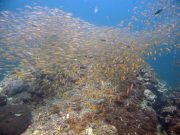

Since Hin Daeng starts more shallow, we usually like to do this as the second dive, depending on the currents and sea conditions.
Hin Daeng: The Pinnacle
At the heart of Hin Daeng is its main pinnacle, a towering underwater rock formation that rises from the depths and breaks the surface. The pinnacle is the starting point for most dives and has steep walls, which descend dramatically into the surrounding depths.
The top of the pinnacle is teeming with life, including schools of fusiliers, damselfish, and other small reef fish that swarm around the rock. The walls are encrusted with red and purple soft corals, sponges, sea fans and whip corals, creating a colourful backdrop for your dive.
The area is also adorned with red and purple soft corals, which give Hin Daeng its name and provide a vibrant backdrop for underwater photography. The shallow waters here are often bright with sunlight, enhancing the colours of the corals and making it a visually stunning start to any dive.
The soft and hard coral formations are home to millions of reef fish, together with boxer shrimps, ghost pipefish, frogfish, octopus and giant morays.
Schools of jack fish, barracudas, trevally, mackerel and rainbow runners circle around the pinnacle to feed.
Hin Daeng: The North Wall And Canyon
As you descend along the pinnacle’s north side, the wall drops to a rocky and uneven plateau at around 12 - 15 metres. A canyon cuts through the rocky plateau area, between the pinnacle and the deeper north wall face, which itself drops to more than 50 metres.
The north wall and canyon area is a hotspot for soft corals, with large patches of red and purple corals clinging to the rock, swaying with the current.
The north wall is also where you’re likely to encounter larger marine life, such as barracudas and trevallies, which patrol the deeper waters. The wall’s steep slope offers plenty of nooks and crannies where smaller creatures like moray eels, scorpionfish, and octopuses can be found hiding.
Hin Daeng: The South Wall
On the south side of Hin Daeng, the wall is equally impressive, dropping steeply to 45 m+.
The south wall tends to be less exposed to strong currents, making it a calmer area to explore. This side is often frequented by smaller reef fish, and you’re more likely to see lionfish, butterflyfish, and angelfish gliding among the corals.
The south wall also features several overhangs and ledges that provide shelter for various species, including lobsters and crabs.
The combination of soft and hard corals creates a diverse habitat that supports a wide range of marine life, including a resident population of batfish, which regularly hangs out along the south wall.
Hin Daeng: The Coral Gardens
Hin Daeng also features extensive coral gardens, which spread out from the base of the pinnacle and extend down the slopes.
These gardens are a riot of colour and life, making them one of the most enjoyable parts of the dive site to explore.
The Shallow Coral Gardens
In the shallower areas, around 10 to 20 metres deep, the coral gardens are dominated by soft corals, particularly the red and purple varieties that Hin Daeng is famous for. These corals create a vibrant environment, attracting a multitude of reef fish.
Schools of snappers, goatfish, and damselfish are commonly seen darting among the corals, while larger species like groupers and wrasses patrol the area.
The shallow coral garden is also a good place to spot smaller, more cryptic species, such as nudibranchs and flatworms, which are often found crawling on the coral surfaces.
The Deeper Coral Gardens
As you move deeper, the coral gardens transition to include more hard corals, such as staghorn corals, brain corals, and table corals. These corals provide structure and habitat for a variety of marine life, including reef fish, invertebrates, and crustaceans.
The deeper coral gardens, typically found between 15 and 30 metres, are also home to larger species like moray eels, which can be seen peering out from the crevices, and the occasional turtle, which feeds on the sponges and soft corals.
The diversity of the coral species and the abundance of marine life make this area a favourite among underwater photographers and macro enthusiasts.
Hin Daeng: The Anemone Fields
Scattered throughout Hin Daengs coral gardens are patches of anemones, home to colourful clownfish and anemonefish. These anemone fields are particularly popular with divers, as they offer a chance to observe the symbiotic relationship between the anemones and their inhabitants up close.
The anemones themselves are often teeming with life, including cleaner shrimp and porcelain crabs, which take advantage of the protection provided by the anemone’s stinging tentacles.
Hin Daeng: The Drop-Offs
One of the most stunning aspects of diving at Hin Daeng is exploring its dramatic drop-offs, where the seabed plunges steeply into the depths.
These drop-offs are located on the southern and western sides of Hin Daeng and are among the deepest parts of pinnacle, with the seabed dropping to over 60 metres in some areas.
Southern Drop-Off
The southern drop-off is one of the most popular areas for divers seeking encounters with larger pelagic species. The drop-off begins at around 30 metres and descends sharply into the blue abyss. This area is sometimes patrolled by grey reef sharks, which can be seen cruising along the wall, and barracudas, which hunt in the deeper waters.
Western Drop-Off
The western drop-off offers a similar experience, with the wall plunging steeply into the depths. This area is known for its strong currents, which can make the dive challenging but also bring in nutrient-rich waters that attract a variety of marine life.
The western drop-off is a good place to encounter schools of jacks and trevallies, which are often seen hunting smaller fish in the currents. The wall itself is covered in soft corals and gorgonian sea fans, which provide shelter for smaller species such as seahorses and hawkfish.
Hin Daeng: Overhangs and Ledges
Hin Daeng is also home to several overhangs and ledges that provide shelter and hiding places for a variety of marine life. These features are scattered around the pinnacle and along the walls, creating mini-ecosystems within the larger dive site.
Shallow Overhangs
In the shallower areas, the overhangs are often home to a variety of invertebrates and small fish. These overhangs are lined with soft corals, sponges, and sea fans, creating a colourful and complex habitat.
Divers can often spot moray eels, scorpionfish and lionfish lurking in the shadows, waiting to ambush their prey. The overhangs are also a good place to find crustaceans such as lobsters and crabs, which take advantage of the protection provided by the rock formations.
Deeper Overhangs
As you move deeper, the ledges become more pronounced, providing shelter for larger species. These ledges are often covered in gorgonian sea fans, which create a beautiful and intricate backdrop.
The deeper ledges are a good place to spot larger reef fish, such as groupers and snappers, which use the ledges as hunting grounds. These deeper ledges also attract pelagic species such as jacks and trevallies, which patrol the area in search of food.
Hin Daeng: Small Caves
Hin Daeng also features a few small caves and crevices that are home to a variety of marine life. These caves are often inhabited by shy species such as octopuses and cuttlefish, which use the darkness as a hiding place.
The caves are also a good place to find nudibranchs and other macro life, which thrive in the sheltered environment. Exploring these hidden features adds an element of discovery to the dive, as you never know what you might find lurking in the shadows.
Hin Daeng: Sandy Areas
At the base of the pinnacle and along the edges of the coral gardens, Hin Daeng features areas of sandy slopes that provide a quiet refuge for a variety of marine species. These sandy areas are often overlooked by divers, but they offer a different kind of underwater experience.
The sandy flats at Hin Daeng are home to a variety of benthic species, including stingrays, flounders, and garden eels. The stingrays are often seen buried in the sand, with only their eyes and tails visible, while the garden eels rise from their burrows, swaying with the current as they feed on plankton.
The sandy flats are also a good place to spot macro life, such as nudibranchs and flatworms, which are often found crawling along the sandy substrate.
Hin Daeng: Dive Site Guide
- NameHin Daeng
- Visibility10m - 30m +
- Level of DivingExperienced Divers Only
- SnorkelingNo
- Depth1m - 55m +
- CurrentsMedium to Strong
- Journey Time60 - 75 mins

Book online to save 10% on dive trips and scuba courses on Koh Lanta.
Hin Muang
Just a short distance from Hin Daeng lies Hin Muang, or "Purple Rock," named for the dense covering of purple, red, and lilac soft corals that blanket its ridges and ledges. These countless soft corals feed on plankton drifting past on the currents.
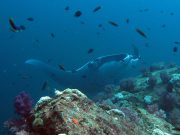
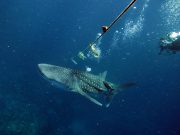
Hin Muang is an elongated pinnacle starting around 12 metres, descending to over 65 metres. The pinnacle features a series of ridges, ledges, and vertical walls that offer diverse underwater terrain. The site is slightly more compact than Hin Daeng but equally rich in marine life.
Hin Muang: The Pinnacle
At the core of Hin Muang is the main pinnacle, which is entirely submerged, with its highest point lying just a few metres below the surface.


The pinnacle is the focal point of the dive site, and its steep walls plunge down to depths of over 60 metres. This vertical drop-off is one of the most striking features of Hin Muang, providing a dramatic backdrop for divers.
Top of the Pinnacle
The top of the pinnacle is an excellent starting point for dives, as it lies at a depth of around 8 to 10 metres.
This area is typically teeming with small reef fish such as damselfish, fusiliers, and butterflyfish. The purple soft corals that give Hin Muang its name are especially abundant here, creating a vibrant and colourful environment.
The currents at the top can be strong, but they bring nutrient-rich water that supports a thriving ecosystem.
The Vertical Walls
As you descend along the walls of the pinnacle, you'll encounter a sheer drop-off that extends to around 65 metres. The walls are covered in soft corals, sea fans, and sponges, providing shelter for a variety of marine life.
This vertical habitat is ideal for spotting pelagic species such as barracudas and trevallies, which often patrol the deeper waters. The walls also attract large schools of fusiliers, which can be seen darting in and out of the coral formations.
Deeper Areas
At greater depths, particularly below 30 metres, divers may encounter larger pelagic species such as grey reef sharks.
These deeper sections are also home to gorgonian sea fans, which are some of the largest and most intricate coral structures at Hin Muang. The sea fans provide a habitat for seahorses, which are masters of camouflage and can be difficult to spot without a keen eye.
Hin Muang: The Ridges
One of the most distinctive features of Hin Muang is its series of ridges that extend from the main pinnacle.
These ridges create a natural corridor that channels currents and attracts a diverse range of marine life. The ridges vary in depth, with some starting as shallow as 15 metres and descending to over 40 metres.
The Shallow Ridges
The shallower ridges are typically covered in a mix of hard and soft corals, creating a colourful underwater garden. These areas are ideal for exploring the smaller, more cryptic species that inhabit Hin Muang. Look closely among the corals, and you might spot nudibranchs, porcelain crabs, and various species of shrimp. The ridges are also frequented by lionfish, which use their venomous spines to deter predators while they hunt for small fish.
The Deeper Ridges
As you move along the ridges, the depth increases, and the topography becomes more rugged. The deeper ridges are often swept by strong currents, which can make for exhilarating drift dives. These currents bring in nutrient-rich water, supporting a higher density of marine life. Large schools of snapper, trevally, and barracuda are commonly seen patrolling the ridges, and the occasional sighting of a leopard shark resting on the sandy bottom is not uncommon.
The Ridge Edges
The edges of the ridges often drop off sharply, creating mini drop-offs that are lined with gorgonian sea fans and whip corals. These edges are a good place to spot pelagic species, as they tend to use the ridges as a highway, swimming along the currents. The ridges also provide excellent opportunities for spotting manta rays, particularly during the manta season from November to April.
Hin Muang: The Plateaus
Hin Muang also features several plateaus, which are flat or gently sloping areas that extend out from the main pinnacle and ridges. These plateaus vary in depth, with some located at around 20 metres and others deeper at 30 to 40 metres. The plateaus offer a change of pace from the vertical walls and ridges, providing a more open environment to explore.
Shallow Plateaus
The shallower plateaus are often covered in a mix of stony corals and soft corals, creating a diverse habitat for reef fish.
This area is home to a variety of species, including triggerfish, pufferfish, and angelfish. The plateaus are also a good place to spot larger reef inhabitants, such as moray eels and octopuses, which can often be found hiding in crevices and under overhangs.
Deep Plateaus
The deeper plateaus are typically more exposed to currents, which can make them more challenging to dive but also more rewarding. These plateaus are often frequented by larger species, including Emperors, snapper, barracuda and giant grouper.
The deeper plateaus also feature large patches of anemones, home to colourful clownfish, and a variety of anemonefish species. The combination of strong currents and diverse coral cover makes these areas particularly rich in marine life.
Hin Muang: Cleaning Stations
Some of the plateaus at Hin Muang serve as cleaning stations, where larger fish come to have parasites removed by cleaner wrasses and cleaner shrimp.
These cleaning stations are fascinating to observe, as they offer a glimpse into the symbiotic relationships that exist in the marine world.
Divers often see manta rays, groupers, and even sharks visiting these stations, making it an excellent opportunity for close encounters with these species.
Hin Muang: The Drop-Offs
Hin Muang’s drop-offs are among the most dramatic features of the dive site. These steep walls descend into the abyss, with depths that can exceed 60 metres. The drop-offs are both intimidating and awe-inspiring, offering divers a sense of the vastness of the ocean.
The Drop-Off Edge
The edge of the drop-off is often where divers first encounter the sheer wall that characterises Hin Muang. This area is teeming with life, as the nutrient-rich upwellings from the deep attract a variety of species. Schools of fusiliers, snappers, and jacks are commonly seen cruising along the drop-off, often followed by larger predators such as barracudas and trevallies.
The Deep Walls
Descending along the walls of the drop-off, divers will notice the change in marine life as they reach greater depths. The soft corals become less dense, and the walls are often lined with gorgonian sea fans and black corals. This is the realm of the deep-water species, including grey reef sharks and giant groupers. These deeper sections are also where divers have the best chance of encountering the elusive whale shark, which occasionally makes an appearance at Hin Muang.
Hin Muang: Into The Blue
Beyond the drop-off, the wall gives way to the blue abyss, a vast expanse of open water that stretches beyond the limits of visibility.
This area is where pelagic species are most likely to be encountered, as they swim in from the deep ocean. Manta rays are known to frequent this area, often seen gliding effortlessly through the water as they approach the cleaning stations or feed on plankton brought in by the currents.
For those with deep-diving experience, exploring the drop-off can be a thrilling experience, offering a sense of adventure and discovery as you descend into the unknown.
Hin Muang: The Sandy Bottoms
At the base of the pinnacle and ridges, Hin Muang features areas of sandy bottoms, which are often overlooked but can be surprisingly rich in marine life. These sandy areas are typically found at depths of 30 to 50 metres and offer a different kind of diving experience.
The Sand Flats
The sand flats are home to a variety of benthic creatures, including flounders, stingrays, and garden eels. The stingrays are often seen buried in the sand, with only their eyes and tails visible, while the garden eels rise from their burrows, swaying with the current as they feed on plankton. The sand flats are also a good place to spot macro life, such as nudibranchs and flatworms, which are often found crawling along the sandy substrate.
The Isolated Coral Bommies
Scattered throughout the sandy bottoms are isolated coral bommies, which are small outcroppings of coral that provide shelter for various marine species.
These bommies are often teeming with life, as they serve as a refuge for smaller fish, such as gobies and blennies, as well as crustaceans like shrimp and crabs.
The bommies also attract larger predators, such as lionfish and scorpionfish, which lie in wait for unsuspecting prey.
Hin Muang: Dive Site Guide
- NameHin Muang
- Visibility10m - 30m +
- Level of DivingExperienced Divers Only
- SnorkelingNo
- Depth12m - 60m +
- CurrentsMedium to Strong
- Journey Time60 - 75 mins
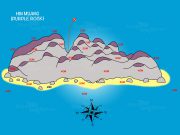
Book online to save 10% on dive trips and scuba courses on Koh Lanta.
Currents & Air Consumption
Experienced Divers Only
You can expect medium to stronger currents while diving at Hin Daeng & Hin Muang, and you must be comfortable making a mid-water ascent and safety stop with no physical reference in stronger currents.
We recommend the SSI Advanced Adventurer course for less experienced divers, which can provide a safe introduction to deeper dives in stronger currents.
These famous dive sites are also a great place to get certified to dive on Enriched Air Nitrox.
Good air consumption is necessary while diving these sites, and this dive site may not be suitable for those who are slow to equalise or may have equalising problems.
Hin Daeng & Hin Muang: Getting There
Speedboat From Koh Lanta
Diving Hin Daeng & Hin Muang from Koh Lanta by speed boat means shorter journey times, typically only 60 - 75 minutes from our office at Lanta Castaway Beach Resort.
Our dive shop is located at the south end of Long Beach on Koh Lanta, and we are the closest dive shop in Thailand to Hin Daeng & Hin Muang.
If you don’t want to waste most of the day on a larger, slower dive boat, our speed boats are the perfect way to dive these wonderful sites from Koh Lanta.
Hin Daeng & Hin Muang Diving Price
Koh Lanta Dive Trips
Fun Diving price at Hin Daeng & Hin Muang is ฿3,950 for 2 dives. Diving price includes dive guide, free equipment rental, lunch & soft drinks on the boat when booked online in advance.
- 2 Dives
- FREE Equipment Rental
- Dive Guide
- Lunch & Soft Drinks
- 2 Dives
- FREE Equipment Rental
- Dive Guide
- Lunch & Soft Drinks
- You must be certified minimum SSI/PADI Open Water Diver, CMAS 1 Star Diver, BSAC Ocean Diver, or equivalent.
- Does not include Marine Park Diving Fee: Thai ฿240, Foreigner ฿600, per day.
See a complete list of all our Koh Lanta Diving Prices.
Book online to save 10% on dive trips and scuba courses on Koh Lanta.
Coral Reef Conservation
Protecting marine life at Hin Daeng & Hin Muang
Hin Daeng & Hin Muang are part of the Mu Ko Lanta National Park, a marine protected area. This status helps preserve the underwater ecosystem at Hin Daeng & Hin Muang, and ensures sustainable tourism practices.
Divers visiting Hin Daeng & Hin Muang are encouraged to follow guidelines that minimise their impact on the environment.
Responsible Diving Practices
To protect the delicate marine environment, divers are urged to follow responsible diving practices, including:
- Avoid touching or disturbing marine life while diving at Hin Daeng & Hin Muang: Many marine organisms are delicate and can be harmed by human contact.
- Practice good buoyancy control while diving at Hin Daeng & Hin Muang: Maintaining proper buoyancy helps prevent accidental damage to corals and other marine life.
- Do not collect souvenirs from Hin Daeng & Hin Muang: Removing shells, corals, or other marine life from the sea is illegal and harmful to the ecosystem.
- Dispose of waste properly: Do not throw any rubbish or food into the sea, especially at the dive site. Throwing food into the water at a coral reef interferes with the delicate marine eco-system.
- Use Reef Safe Sun Block: Ensure your sunscreen is Reef Safe and does not harm the corals and marine life at Hin Daeng & Hin Muang.
Koh Lanta Dive Sites
Some of Thailand's Best Diving
Hin Daeng & Hin Muang are some of the best dive sites in Thailand, and can be easily dived from Koh Lanta by speedboat along with many of Thailand's other top dive sites:
- Lanta Marine Park
- Koh Haa Islands
- Koh Rok Islands
- Hin Daeng & Hin Muang
- Hin Musang Wildlife Reserve
- Shark Point & Anemone Reef
- Phi Phi Marine Park
- Bida Nok & Bida Nai
- Hin Bida
- Koh Phi Phi
- HTMS Kledkaeo Wreck
- Hin Klai
Find out more at the Thai Department of National Parks.
Our Dive Trip Schedule
Lanta Dive trips from 15 Oct - 15 May
Our dive trips depart Koh Lanta in the morning every day during high season from the south end of Long Beach, normally returning around 1:30 - 2pm.
| Week Day | Boat 1 | Boat 2 |
| Monday | Koh Bida / Phi Phi | Koh Bida / Phi Phi |
| Tuesday | Koh Haa Islands | Hin Daeng & Hin Muang |
| Wednesday | Koh Bida / Phi Phi | Koh Bida / Phi Phi |
| Thursday | Koh Haa Islands | Koh Haa Islands |
| Friday | Koh Haa Islands | Hin Daeng & Hin Muang |
| Saturday | Koh Bida / Phi Phi | Koh Bida / Phi Phi |
| Sunday | Koh Haa Islands | Koh Haa Islands |
- All trips are 2 dives a day
- Trips depart from the beach at our dive shop @ Lanta Castaway Beach Resort
- Trips Depart 8/9am, return 2pm
- Dive & Relax is open from Oct 15 - May 15.
- E-mail us info@diveandrelax.com in advance with any questions, or to make a booking.
We may schedule a Shark Point & Anemone Reef dive trip or a KledKaeo Wreck & Hin Klai dive trip upon request. A minimum of 5 divers are required for these trips, please let us know if you are interested.
We love to dive as much as possible during the high season, however all our dive trips depend on the weather, sea conditions, currents and minimum numbers and may be subject to change at short notice.
For more information on our weather and climate, check out the best time to visit Koh Lanta.
Book online to save 10% on dive trips and scuba courses on Koh Lanta.


